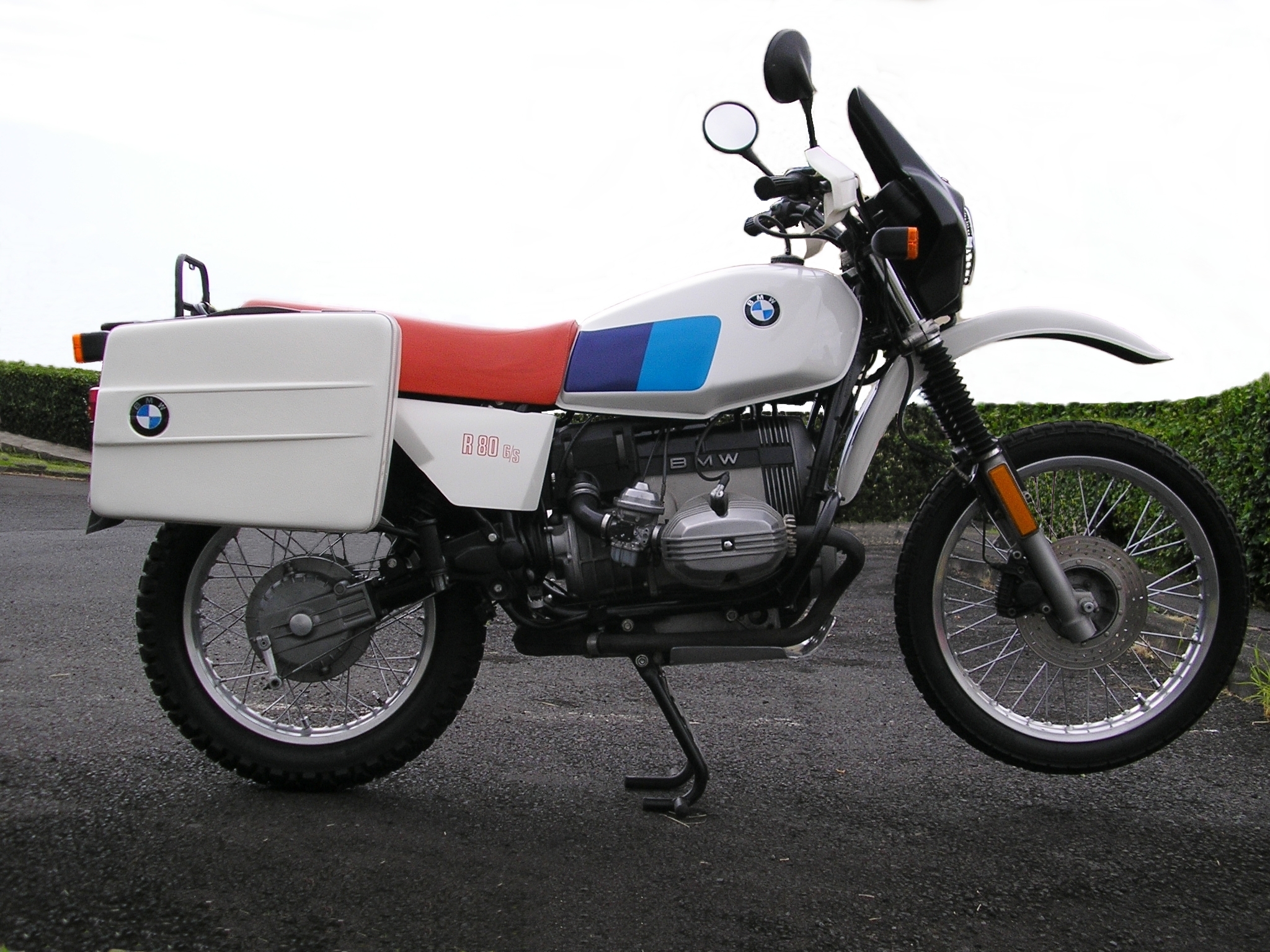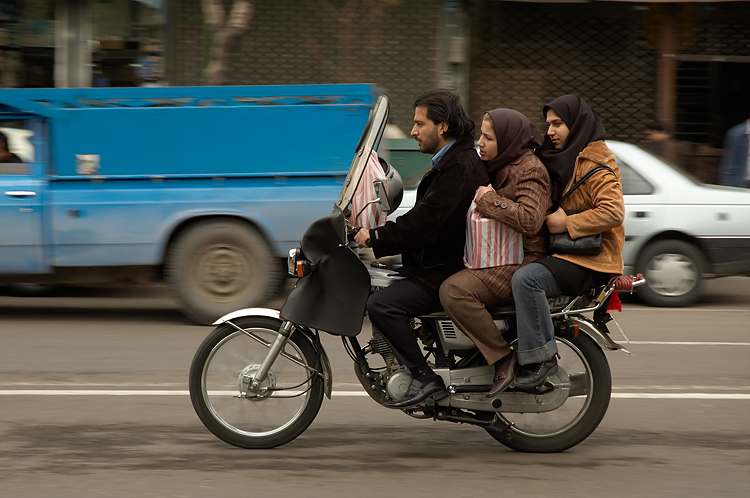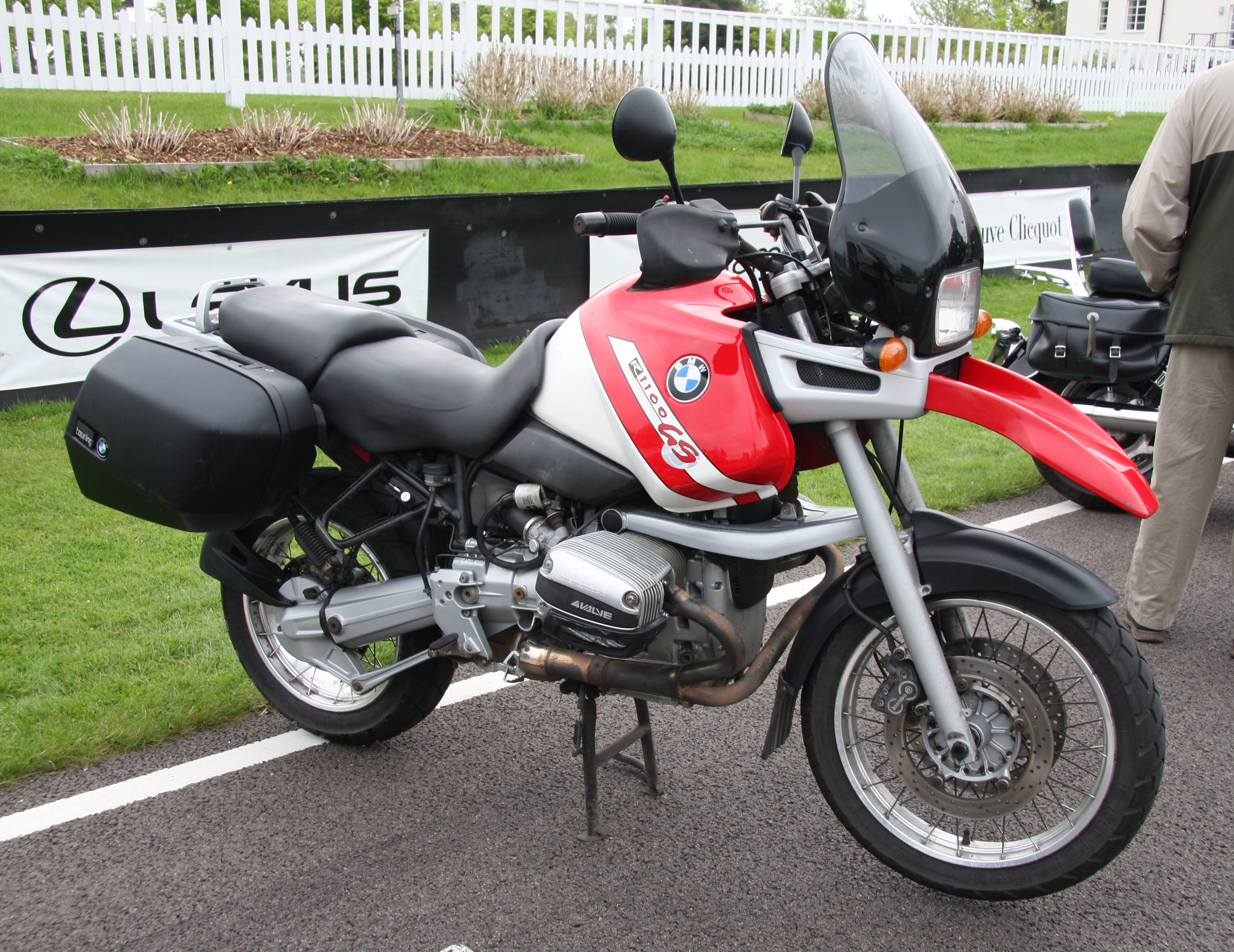|
BMW GS
The BMW GS series of one purpose off-road/on-road BMW motorcycles have been produced from 1980, when the R80G/S was launched, to the present day. The GS refers to either Gelände/Straße (German: off-road/road) or Gelände Sport. GS motorcycles can be distinguished from other BMW models by their longer travel suspension, an upright riding position, and larger front wheels – typically 19 to 21 inch. In May 2009, the 500,000th GS was produced, an R1200GS model. GS models The GS has been available with a range of different engines, including single-cylinder, twin-cylinder water-cooled and twin-cylinder air- ("Airheads") and air/oil-cooled ("Oilheads" and "Hexheads"). Airheads The first shaft driven GS model was the R80G/S with a 797.5 cc air-cooled, flat-twin boxer engine. The BMW 247 engine, which was also fitted to many other bikes in the BMW range, is known as an airhead, because it relies on airflow across the cylinder heads and cylinder 'barrels' to pro ... [...More Info...] [...Related Items...] OR: [Wikipedia] [Google] [Baidu] |
BMW R80G/S
The BMW R 80 G/S is a motorcycle that was manufactured in Berlin, Germany, by BMW Motorrad from 1980 to 1987. Production totalled 21,864 bikes. It was the first in the BMW GS family of specialised dual-sport bikes, of which over 500,000 have been produced, and is often considered the world's first "Adventure Bike" able to be equally as capable both on and off-road. The designation G/S stands for the German words Gelände/Straße, which mean offroad/road – highlighting the bike's dual sport design. Specification The R 80 G/S (G for Gelände "offroad" in German S for Straße "street") was the first large displacement multisport bike on the market. The G/S was fitted with a BMW type 247 engine, which is a flat-twin ( boxer) sometimes known as an airhead. The engine, which was fitted into an R65 frame,Falloon, The BMW Story, pp. 85 was a modified version of that fitted to the R 80/7, featuring Nikasil cylinders, electronic ignition and a lighter flywheel. At the rear the b ... [...More Info...] [...Related Items...] OR: [Wikipedia] [Google] [Baidu] |
Oilhead
BMW's motorcycle history began in 1921 when the company commenced manufacturing engines for other companies. BMW's own motorcycles—sold under the BMW Motorrad brand—began in 1923 with the BMW R 32, which was powered by a flat-twin engine (also called a "boxer-twin" engine). Production of motorcycles with flat-twin engines continues to this day, however BMW has also produced many models with other types of engines. Motorcycle history 1921–1938 At the end of World War I, the Treaty of Versailles demanded that BMW cease production of aircraft engines. To remain in business, the company began producing small industrial engines (along with farm equipment, household items and railway brakes). In 1920, BMW M2B15 flat-twin petrol engine was released. Despite being designed as a portable industrial engine, the M2B15 was also used by several motorcycle manufacturers, including for the 1920–1923 Victoria KR1 and the 1920–1922 Bayerische Flugzeugwerke (BFw) ''Helios'' motorc ... [...More Info...] [...Related Items...] OR: [Wikipedia] [Google] [Baidu] |
Airhead (motorcycle)
BMW's motorcycle history began in 1921 when the company commenced manufacturing engines for other companies. BMW's own motorcycles—sold under the BMW Motorrad brand—began in 1923 with the BMW R 32, which was powered by a flat-twin engine (also called a "boxer-twin" engine). Production of motorcycles with flat-twin engines continues to this day, however BMW has also produced many models with other types of engines. Motorcycle history 1921–1938 At the end of World War I, the Treaty of Versailles demanded that BMW cease production of aircraft engines. To remain in business, the company began producing small industrial engines (along with farm equipment, household items and railway brakes). In 1920, BMW M2B15 flat-twin petrol engine was released. Despite being designed as a portable industrial engine, the M2B15 was also used by several motorcycle manufacturers, including for the 1920–1923 Victoria KR1 and the 1920–1922 Bayerische Flugzeugwerke (BFw) ''Helios'' motorcyc ... [...More Info...] [...Related Items...] OR: [Wikipedia] [Google] [Baidu] |
Motorcycling
Motorcycling is the act of riding a motorcycle. For some people, motorcycling may be the only affordable form of individual motorized transportation, and small- displacement motorcycles are the most common motor vehicle in the most populous countries, including India, China and Indonesia. In developing countries, motorcycles are overwhelmingly utilitarian due to lower prices and greater fuel economy. Of all motorcycles, 58% are in the Asia Pacific and Southern and Eastern Asia regions, excluding car-centric Japan. Motorcycles are mainly a luxury good in developed nations, where they are used mostly for recreation, as a lifestyle accessory or a symbol of personal identity. Beyond being a mode of motor transportation or sport, motorcycling has become a subculture and lifestyle. Although mainly a solo activity, motorcycling can be social and motorcyclists tend to have a sense of community with each other. Reasons for riding a motorcycle For most riders, a motorcycle is a ... [...More Info...] [...Related Items...] OR: [Wikipedia] [Google] [Baidu] |
Torque
In physics and mechanics, torque is the rotational equivalent of linear force. It is also referred to as the moment of force (also abbreviated to moment). It represents the capability of a force to produce change in the rotational motion of the body. The concept originated with the studies by Archimedes of the usage of levers, which is reflected in his famous quote: "''Give me a lever and a place to stand and I will move the Earth''". Just as a linear force is a push or a pull, a torque can be thought of as a twist to an object around a specific axis. Torque is defined as the product of the magnitude of the perpendicular component of the force and the distance of the line of action of a force from the point around which it is being determined. The law of conservation of energy can also be used to understand torque. The symbol for torque is typically \boldsymbol\tau, the lowercase Greek letter ''tau''. When being referred to as moment of force, it is commonly denoted by . I ... [...More Info...] [...Related Items...] OR: [Wikipedia] [Google] [Baidu] |
V-twin
A V-twin engine, also called a V2 engine, is a two-cylinder piston engine where the cylinders share a common crankshaft and are arranged in a V configuration. Although widely associated with motorcycles (installed either transversely or longitudinally), V-twin engines have also been used for industrial engines and in several small cars. The V-twin design dates back to the late 1880s. Origins One of the first V-twin engines was built by Gottlieb Daimler in 1889. It was used as a stationary engine, for boats and in the Daimler Stahlradwagen ("steel-wheeled car"), Daimler's second car. The engine was also manufactured under licence in France by Panhard et Levassor. An early V-twin engined motorcycle was produced in November 1902 by the Princeps AutoCar Company in the United Kingdom. The following year, V-twin motorcycles were produced by Eclipse Motor & Cycle Co in the United Kingdom (the ''XL-ALL'' model), Glenn Curtiss in the United States, and NSU Motorenwerke in Germ ... [...More Info...] [...Related Items...] OR: [Wikipedia] [Google] [Baidu] |
Inline-four Engine
A straight-four engine (also called an inline-four) is a four-cylinder piston engine where cylinders are arranged in a line along a common crankshaft. The vast majority of automotive four-cylinder engines use a straight-four layout (with the exceptions of the flat-four engines produced by Subaru and Porsche) and the layout is also very common in motorcycles and other machinery. Therefore the term "four-cylinder engine" is usually synonymous with straight-four engines. When a straight-four engine is installed at an inclined angle (instead of with the cylinders oriented vertically), it is sometimes called a slant-four. Between 2005 and 2008, the proportion of new vehicles sold in the United States with four-cylinder engines rose from 30% to 47%. By the 2020 model year, the share for light-duty vehicles had risen to 59%. Design A four-stroke straight-four engine always has a cylinder on its power stroke, unlike engines with fewer cylinders where there is no power stroke occu ... [...More Info...] [...Related Items...] OR: [Wikipedia] [Google] [Baidu] |
Spark Plug
A spark plug (sometimes, in British English, a sparking plug, and, colloquially, a plug) is a device for delivering electric current from an ignition system to the combustion chamber of a spark-ignition engine to ignite the compressed fuel/air mixture by an electric spark, while containing combustion pressure within the engine. A spark plug has a metal threaded shell, electrically isolated from a central electrode by a ceramic insulator. The central electrode, which may contain a resistor, is connected by a heavily insulated wire to the output terminal of an ignition coil or magneto. The spark plug's metal shell is screwed into the engine's cylinder head and thus electrically grounded. The central electrode protrudes through the porcelain insulator into the combustion chamber, forming one or more spark gaps between the inner end of the central electrode and usually one or more protuberances or structures attached to the inner end of the threaded shell and designated the ' ... [...More Info...] [...Related Items...] OR: [Wikipedia] [Google] [Baidu] |
Anti-lock Braking System
An anti-lock braking system (ABS) is a safety anti-skid braking system used on aircraft and on land vehicles, such as cars, motorcycles, trucks, and buses. ABS operates by preventing the wheels from locking up during braking, thereby maintaining tractive contact with the road surface and allowing the driver to maintain more control over the vehicle. ABS is an automated system that uses the principles of threshold braking and cadence braking, techniques which were once practiced by skillful drivers before ABS was widespread. ABS operates at a much faster rate and more effectively than most drivers could manage. Although ABS generally offers improved vehicle control and decreases stopping distances on dry and some slippery surfaces, on loose gravel or snow-covered surfaces ABS may significantly increase braking distance, while still improving steering control. Since ABS was introduced in production vehicles, such systems have become increasingly sophisticated and effectiv ... [...More Info...] [...Related Items...] OR: [Wikipedia] [Google] [Baidu] |
BMW R1100GS
The BMW R1100GS is a dual-sport motorcycle that was launched in 1993, and manufactured from 1994 to 1999 by BMW Motorrad in Berlin, Germany.Schneider & Koenigsbeck, pp. 64 The bike has a flat-twin (boxer) engine, first seen in the R1100RS which was launched the year before in 1992, and was the first member of the GS family to use an air- and oil-cooled engine rather than the earlier air-cooled airhead engines which had been used on BMW motorcycles since the R32 in 1923. A smaller capacity sister model, the R850GS, was produced from 1996 to 2001. In 1999, the R1100GS was superseded by the R1150GS. Technical features Previous BMW motorcycles used the airhead engines such as the type 247 air-cooled flat-twin with two pushrod-activated valves per cylinder. The R1100GS engine introduced partial oil-cooling and four valves per cylinder operated by a single chain-driven camshaft. Motronic fuel injection was included instead of the carburettors found on earlier bikes. Rear suspe ... [...More Info...] [...Related Items...] OR: [Wikipedia] [Google] [Baidu] |
BMW R850GS
The BMW R1100GS is a dual-sport motorcycle that was launched in 1993, and manufactured from 1994 to 1999 by BMW Motorrad in Berlin, Germany.Schneider & Koenigsbeck, pp. 64 The bike has a flat-twin (boxer) engine, first seen in the R1100RS which was launched the year before in 1992, and was the first member of the GS family to use an air- and oil-cooled engine rather than the earlier air-cooled airhead engines which had been used on BMW motorcycles since the R32 in 1923. A smaller capacity sister model, the R850GS, was produced from 1996 to 2001. In 1999, the R1100GS was superseded by the R1150GS. Technical features Previous BMW motorcycles used the airhead engines such as the type 247 air-cooled flat-twin with two pushrod-activated valves per cylinder. The R1100GS engine introduced partial oil-cooling and four valves per cylinder operated by a single chain-driven camshaft. Motronic fuel injection was included instead of the carburettors found on earlier bikes. Rear susp ... [...More Info...] [...Related Items...] OR: [Wikipedia] [Google] [Baidu] |







